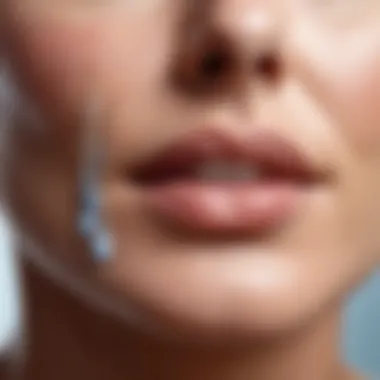Peptides for Wrinkle Reduction: An In-depth Analysis


Intro
In recent years, the discussion surrounding skincare has increasingly turned towards the role of peptides. These short chains of amino acids play a significant role in various biological functions. Their application in skincare, especially in wrinkle reduction, is becoming a focal point as more individuals seek effective solutions for aging concerns.
Peptides can signal cells to perform specific functions, which is vital in skin health. By understanding their scientific basis, one can better appreciate how they can enhance skin appearance and potentially minimize the signs of aging. This article aims to explore the mechanisms of action peptides employ against wrinkles, the types available, and the importance of high-quality products in achieving desired results.
Popular Discounts and Offers
The world of skincare can be overwhelming, especially when it comes to price and quality. Being informed about available discounts can significantly impact your purchasing decisions. Many reputable skincare brands offer seasonal sales that can be beneficial for consumers.
Overview of Current Discounts on Skincare Brands
Brands such as The Ordinary, Paula’s Choice, and SkinCeuticals often run promotions that include:
- Limited-time discounts during specific holidays such as Black Friday or Valentine’s Day.
- Membership deals or loyalty programs that provide discounts for regular customers.
- Bundled products at a reduced rate to encourage users to try new items.
Seasonal Sales and Special Offers
As seasons change, so do skincare needs. Certain brands also offer:
- Seasonal sales aligned with summer or winter skincare routines.
- Exclusive offers during significant events like skin awareness months.
- Promotions connected to newly launched products that introduce innovative ingredients, including peptides.
By staying aware of these opportunities, consumers can make more informed purchases while enjoying high-quality skincare products infused with effective peptides.
Recommendations for Choosing Skincare Products
Navigating the skincare industry requires understanding not only the ingredients but also the type of products suitable for different skin types and ages. Choosing the correct formulation is crucial for achieving the best results from peptide use.
How to Choose Skincare Products by Skin Type
Each skin type has unique needs, and recognizing these is essential.
- Oily Skin: Lightweight formulations often labeled as gel-based are ideal. Look for peptides that enhance hydration without clogging pores.
- Dry Skin: A cream or lotion with rich emulsifiers combined with peptides can assist in moisture retention, reducing visible wrinkles.
- Combination Skin: A balanced formula is key, ensuring it addresses both dry and oily areas effectively.
- Sensitive Skin: Gentle products with fewer irritants are necessary; peptides can calm inflammation and redness.
Tips for Choosing Skincare Products for Different Age Groups
Age can influence the type of skincare regimen appropriate for effective wrinkle reduction.
- Teens and 20s: Preventative measures, focusing on hydration and defense against environmental stressors, can be beneficial. Using products with mild peptides can help.
- 30s and 40s: Incorporating targeted treatments that combine peptides with other anti-aging ingredients such as hyaluronic acid and antioxidants can yield significant benefits.
- 50s and Beyond: Rich formulations that not only contain peptides but also focus on deep hydration and barrier repair are essential for mature skin.
Understanding these factors ensures that consumers choose the right products to maximize the benefits of peptides in their skincare routines.
Understanding Peptides
Peptides play a critical role in skincare, especially when it comes to reducing wrinkles. They are short chains of amino acids, which are the building blocks of proteins. Understanding peptides is essential for grasping how they influence skin health and appearance. This section discusses the various aspects of peptides, their significance in anti-aging products, and their overall benefits.
One of the main reasons why peptides are valued in skincare is their ability to communicate with skin cells. They send signals that can stimulate certain biological processes. This capability is particularly beneficial in enhancing collagen production. Collagen, a key protein in skin structure, diminishes with age, resulting in wrinkles and loss of elasticity. Hence, peptides target the signs of aging directly at the cellular level, making them a popular choice in many formulations aimed at wrinkle reduction.
Additionally, the use of peptides in skincare comes with certain considerations. Not all peptides are created equal; their effectiveness can depend on factors such as concentration, formulation, and the method of delivery. It is important for consumers to understand the specific types of peptides and their characteristics to select the right products that will yield visible results.
Moreover, using products containing peptides can often lead to improved skin hydration and barrier function, offering further benefits beyond wrinkle reduction. This means incorporating peptides into daily skincare routines can not only help in treating existing wrinkles but also prevent new ones from forming.
In summary, a fundamental knowledge of peptides is crucial for those interested in effective skincare strategies. It enables consumers to make informed decisions, thus maximizing the potential benefits of their skincare products.
What Are Peptides?
Peptides are short chains composed of amino acids linked via peptide bonds. They differ from proteins, which are longer chains. This difference in structure influences their function within the skin. Peptides can naturally occur in the body or be synthesized for topical application.
In skincare, they are used extensively for their ability to penetrate the skin and interact with various receptors. This interaction facilitates a range of biological responses, including improved skin firmness and elasticity.
Types of Peptides in Skincare
Peptides in skincare can be categorized into several types, each with distinct functions and benefits.
Signal Peptides
Signal peptides are small chains that communicate directly with skin cells. They send signals that promote cellular regeneration and stimulate collagen production. This is significant for wrinkle reduction as it aids in restoring skin’s firmness.
One key characteristic of signal peptides is their ability to mimic the body's natural signals. This unique feature makes them highly effective in anti-aging formulations. As a result, they are a popular ingredient choice for their potential to visibly improve skin texture and tone.


The advantages of incorporating signal peptides into skincare products include their effectiveness without harsh side effects. However, their performance can rely on proper formulation. The concentration and other ingredients must complement their activity for optimal results.
Carrier Peptides
Carrier peptides serve as delivery agents for trace elements necessary for skin health, such as copper. They facilitate the transport of these essential elements to the skin cells. This aspect is crucial because trace elements support various biological processes, including the formation of collagen and elastin.
A defining feature of carrier peptides is their ability to enhance the skin's ability to regenerate. Their role in delivering necessary nutrients makes them a valuable component in skincare products aimed at revitalizing aging skin.
However, while carrier peptides are beneficial, their effectiveness may depend on the presence of other ingredients that can work synergistically. Ensuring that the product formulation is balanced is key to achieving the desired anti-aging results.
Enzyme-Inhibiting Peptides
Enzyme-inhibiting peptides are designed to interfere with specific enzymes that can break down collagen and elastin. By inhibiting these enzymes, these peptides help to maintain the integrity of the skin structure, thus preventing wrinkles from deepening.
The distinct characteristic of enzyme-inhibiting peptides lies in their protective function. They actively work to preserve the skin's natural scaffolding, making them an essential inclusion in anti-aging products. This trait renders them particularly valuable for those looking to maintain a youthful appearance.
While useful, the effectiveness of enzyme-inhibiting peptides can be impacted by the overall skin condition and other external factors. An appropriate skincare routine is necessary to maximize their benefits.
The Science Behind Wrinkle Formation
Understanding the science behind wrinkle formation is integral to grasping how peptides function effectively as anti-aging agents. Wrinkles signify not only the passage of time but also a decline in skin health, elasticity, and firmness. As the skin ages, its natural ability to regenerate diminishes. This decline can be attributed to various biological and environmental factors, leading to the eventual appearance of wrinkles. In this article, we will explore the key elements of skin structure and aging, and the pivotal roles collagen and elastin play in this process.
Skin Structure and Aging
The skin is a complex organ with multiple layers, each serving a distinct purpose. The outer layer is known as the epidermis, which acts as a barrier against environmental aggressors. Beneath this, the dermis contains collagen and elastin fibers, responsible for skin's strength and elasticity. However, as individuals age, the production of these essential proteins decreases.
Natural aging is affected by intrinsic factors such as genetics and hormonal changes. Additionally, extrinsic factors like UV exposure, pollution, and lifestyle choices contribute significantly to premature aging. Over time, the skin loses its ability to maintain hydration and undergo repair, leading to fine lines and deeper wrinkles.
In summary, understanding skin structure and the aging process underscores the importance of developing skincare solutions that address these changes. By targeting the underlying causes of wrinkles, peptide formulations can provide a more effective approach to enhancing skin health and appearance.
Role of Collagen and Elastin
Collagen and elastin are vital components of skin structure that work synergistically to maintain its integrity and youthful appearance. Collagen, the most abundant protein in the skin, provides structural support and firmness. It acts like a scaffold, giving skin its strength and preventing sagging. On the other hand, elastin enables the skin to stretch and return to its original shape. This elasticity is crucial for maintaining a plump and youthful look.
Unfortunately, the synthesis of both collagen and elastin diminishes with age. Research indicates that after the age of 20, collagen production decreases by about 1% annually. This decline results in a loss of skin volume and resilience, making wrinkles and sagging more pronounced. Furthermore, external factors such as the sun’s ultraviolet rays can degrade collagen and elastin fibers, accelerating the aging process.
"A profound understanding of collagen and elastin's roles enhances the rationale for incorporating peptides into skincare solutions."
Incorporating peptide-based products can stimulate collagen and elastin production. By signaling skin cells to produce more of these proteins, peptides may assist in restoring skin elasticity and firmness. This mechanism highlights the importance of peptides in treating and preventing wrinkles, making them an essential subject in the field of anti-aging skincare.
How Peptides Work to Reduce Wrinkles
Understanding how peptides work to reduce wrinkles is essential in the context of skincare. Peptides are small chains of amino acids that serve as building blocks for proteins in the skin. Their ability to penetrate the skin and stimulate intrinsic processes makes them crucial in the fight against aging. In this section, we will explore the specific mechanisms through which peptides function to combat wrinkles, highlighting their benefits and considerations.
Mechanisms of Action
The actions of peptides in reducing wrinkles can be broken down into three primary mechanisms: stimulating collagen production, improving skin hydration, and enhancing skin barrier function.
Stimulating Collagen Production
The stimulation of collagen production is a central aspect of how peptides reduce wrinkles. Collagen is a protein that helps maintain the skin's firmness and elasticity. As we age, collagen levels decrease, leading to the formation of wrinkles.
Peptides like palmitoyl pentapeptide-4 send signals to fibroblasts, the cells responsible for collagen synthesis. This mechanism not only increases collagen output but also enhances the skin's overall firmness.
Key Characteristic: This process is beneficial as it works with the skin's natural ability to regenerate. The unique feature is that it can trigger collagen synthesis without invasive procedures.
While this is advantageous, there may be some disadvantages. Individuals with sensitive skin could potentially experience reactions. A patch test is advisable before extensive use, ensuring compatibility with skin type.
Improving Skin Hydration
Improving skin hydration is another significant mechanism whereby peptides contribute to wrinkle reduction. Hydrated skin is plump and resilient, which diminishes the visibility of fine lines and wrinkles.
Certain peptides, like acetyl hexapeptide-8, act to encourage the skin's ability to retain moisture. This characteristic makes them crucial for maintaining the skin's appearance. Peptides can help enhance the natural moisturizing factors in the skin, responsible for keeping it hydrated.
Key Characteristic: Hydration is vital for overall skin health. The unique feature here is that peptides can interact with skin layers to improve water retention, providing long-term benefits.
The potential drawback of focusing primarily on hydration is that it may not address wrinkles caused by structural damage in skin. A balanced approach combining hydration and structural support is typically advised.
Enhancing Skin Barrier Function


Enhancing the skin's barrier function is equally important in wrinkle reduction. Peptides help to fortify the skin's outer layer, protecting it from environmental stressors and moisture loss.
When the skin barrier is strong, the skin can better resist external factors that contribute to aging, such as pollution and UV rays. Certain peptides improve lipid synthesis, which is essential for maintaining barrier functionality.
Key Characteristic: A robust skin barrier ensures longevity in skin health. The unique feature of this mechanism is that it provides both preventive and curative benefits.
However, it is crucial to note that individuals with certain skin conditions may require specialized formulations to support barrier function without causing irritation.
"The effectiveness of peptides in skincare relies on their ability to target key biological processes that contribute to skin aging."
Integrating Peptides into Skincare Regimens
Integrating peptides into skincare regimens is critical for individuals seeking to harness their wrinkle-reducing properties. Peptides play several roles in skin health, offering benefits beyond wrinkle reduction. They stimulate collagen production, improve skin hydration, and enhance the skin barrier. Understanding how to effectively incorporate them makes a significant difference in achieving desired results.
Choosing the Right Products
When selecting peptide products, it is essential to consider formulations that deliver peptides effectively. Look for serums and creams that contain collagen-boosting ingredients. Products with multiple types of peptides can maximize benefits. Popular brands focus on quality and concentration of active peptides. Check labels and look for peptides like copper tripeptide-1 or palmitoyl pentapeptide-4, noted for their effectiveness. It is also wise to consider additional ingredients such as hyaluronic acid or antioxidants to complement the action of peptides. Choosing products with minimal irritants can enhance the overall effectiveness on your skin.
Frequency and Method of Application
For optimal results, using peptide-based products correctly is crucial. Most experts recommend applying these products twice daily, ideally in the morning and evening. Cleanse the skin thoroughly before application. It enables peptides to penetrate better. Apply a serum or cream gently, using upward strokes for best results. This method not only enhances absorption but also promotes blood circulation in the skin.
It is important to be consistent with use. Many users begin to notice improvements typically within four to six weeks. Monitor how the skin responds to adjust frequency or formulation if needed. Always consider combining peptide products with other elements of a skincare routine, such as moisturizers and sunscreens. This holistic approach helps maximize the overall skin health benefits.
"Understanding how to properly integrate peptides into your regimen can greatly enhance their efficacy."
Efficacy of Peptides in Clinical Studies
The efficacy of peptides in clinical studies is crucial to understanding their role in skincare. Various studies have investigated how well peptides perform in reducing wrinkles, contributing to skin elasticity, and enhancing overall skin appearance. It is important to consider different factors, including the type of peptides used, their concentration in products, and the duration of treatment. This section aims to elaborate on current research findings and how peptides compare to other anti-aging ingredients.
Current Research Findings
Recent clinical research on peptides has yielded promising results regarding their effectiveness. Many studies have shown a significant reduction in the appearance of fine lines and wrinkles following peptide application. For instance, a study published in the Journal of Cosmetic Dermatology found that participants who used a formulation containing palmitoyl pentapeptide-4 experienced noticeable improvements in skin texture and firmness after 12 weeks of continuous use.
Moreover, research indicates that some peptides, such as Acetyl Hexapeptide-8, may help inhibit muscle movement in facial areas, potentially leading to a botox-like effect. This investigation revealed that individuals who incorporated this peptide into their skincare routine reported reduced expression lines.
"The evidence from clinical trials supports the effectiveness of peptides as a viable solution for wrinkle reduction, showcasing a growing interest in peptide-based formulations in skincare."
Additionally, the combination of peptides with other beneficial ingredients can enhance their effectiveness. For example, several studies suggest that integrating peptides with hyaluronic acid enhances hydration and promotes a plumper skin appearance. This synergy can lead to better outcomes in clinical settings and for consumer use in everyday routines.
Comparative Studies with Other Anti-Aging Ingredients
When comparing peptides to other anti-aging ingredients, results vary significantly. Many ingredients, like retinoids and alpha hydroxy acids, have long been staples in the anti-aging category due to extensive research backing their efficacy. Retinoids, known for stimulating cell turnover and collagen production, have shown impressive results in wrinkle reduction. However, they can often cause irritation and peeling, making peptides an attractive alternative, especially for sensitive skin types.
Clinical studies comparing peptides to retinoids have illustrated that peptides tend to have a milder side effect profile while still offering significant anti-aging benefits. Some studies suggest that while retinoids may produce faster results, peptides can provide more gradual improvement without the associated irritation.
Furthermore, a comparison with antioxidants highlights another advantage of peptides. While antioxidants such as Vitamin C combat free radicals and enhance skin brightness, peptides promote skin repair and rebuilding. This makes their benefits complementary rather than mutually exclusive.
Potential Side Effects and Considerations
The application of peptides in skincare presents a promising avenue for wrinkle reduction. However, it is crucial to address potential side effects and important considerations associated with their use. Users should be aware that while peptides are generally safe, they can cause certain reactions or irritations in some individuals. Understanding these factors enhances the effectiveness of peptide products while also safeguarding the skin's integrity.
Common Reactions
When integrating peptides into a daily skincare routine, some users may experience adverse reactions. These reactions can vary in severity based on skin type and individual sensitivities. Common reactions include:
- Redness: This can be a sign of irritation, often minor and temporary, but it is essential to monitor.
- Itching: Some may feel mild to moderate itchiness after application, which could indicate sensitivity to specific peptide formulations.
- Stinging or burning sensation: This is less common but can occur, particularly in individuals with sensitive skin.
Most of these reactions are not serious. However, if side effects persist or worsen, it is advisable to discontinue use and consult a dermatologist. It’s also wise to perform a patch test before fully incorporating peptides into the routine, especially for first-time users.
When to Avoid Peptides
Despite their numerous benefits, there are circumstances under which one should avoid using peptide formulations. It is vital for both women and men, across various age groups, to consider the following factors:
- Active Skin Conditions: Individuals with conditions like eczema or psoriasis should avoid peptides as they may exacerbate irritation and discomfort.
- Sensitivity to Other Ingredients: If a skincare product contains multiple active ingredients that may conflict with peptides, avoiding these combinations is wise.
- Recent Dermatological Treatments: After procedures like chemical peels or laser treatments, the skin may be more sensitive. In such cases, it is best to consult a physician before using peptide products.
Understanding these potential side effects and situations when it's best to avoid peptides is important for maximizing their benefits while ensuring skin safety. Prioritizing skin health over all else cannot be overstated.
Peptides in the Cosmetics Market


The role of peptides in the cosmetics market has grown significantly over the years. Their effectiveness in addressing various skin concerns, notably wrinkle reduction, makes them a sought-after ingredient. As consumers become more informed about skincare, they are increasingly looking for products that provide visible improvements. Peptides cater to this desire by offering a promise of enhanced skin appearance without invasive procedures.
Understanding how peptides are marketed helps consumers make better choices. Many brands tout peptides as key ingredients in their formulations, suggesting a certain level of efficacy. However, not all peptide products are created equal. Therefore, scrutinizing ingredients lists and product claims is crucial to identify which products genuinely harness the power of peptides.
Moreover, the regulatory landscape around cosmetics can affect both the production and marketing of peptide products. Consumers should be aware of variations in regulations across different regions, which might influence the quality and concentration of peptides in products.
Trends and Innovations
The current trends in the cosmetics market reflect a robust demand for innovative peptide formulations. Manufacturers are continuously exploring new types of peptides and delivery mechanisms. For instance, some brands are focusing on bioactive peptides that mimic the body’s natural processes, thus ensuring better skin compatibility and effectiveness.
Innovation also brings attention to the delivery systems used in peptide-infused products. Microneedling, for example, is used to enhance the absorption of peptides into the skin, maximizing their effects. Additionally, advancements in formulation technologies lead to prolonged stability and efficacy of peptides in products, ensuring they remain effective until applied.
"The integration of peptides offers a dual benefit: addressing skin issues and enhancing overall skin health."
Other prevalent trends include promoting sustainable and clean beauty products. Many brands are now emphasizing that their peptides are derived from natural sources, appealing to environmentally-conscious consumers. The rise of personalized skincare based on individual needs has also prompted companies to explore peptide combinations tailored specifically to target wrinkles, dullness, or sagging skin.
As the market evolves, so does the pricing strategy of peptide-based products. Consumers now have options ranging from affordable treatments to high-end luxury lines, allowing them to choose products that fit their budget while still addressing their skincare concerns.
Economic Aspects of Peptide Products
The economic aspects of peptide products are crucial for understanding their place in the skincare industry. As these products continue to gain popularity, it is essential to assess various elements that influence their pricing, demand, and overall market potential. For consumers and manufacturers alike, understanding these economic factors helps in making informed decisions regarding product development and usage.
Cost vs. Benefit Analysis
When evaluating peptide products, a comprehensive cost versus benefit analysis is necessary. This evaluation considers the financial investment required against the advantages that peptides may offer for wrinkle reduction and overall skin health.
- Product Pricing: Many peptide formulations vary widely in cost, influenced by the concentration of active ingredients, brand reputation, and the target market. Higher prices often reflect the quality of components used in synthesis and the research behind product development.
- Efficacy in Results: Clinical studies suggest peptides can effectively reduce wrinkles by promoting collagen synthesis and enhancing skin elasticity. These benefits might justify a higher price tag, as users seek long-term results over temporary fixes.
- Durability of Results: Another factor to consider is the longevity of the results achieved by using peptide products. Users may find that sustained application leads to better and more lasting improvements, potentially making higher-priced products more economically viable in the long term.
- Accessibility: Consumers should consider whether they view peptide products as accessible or too niche. Market saturation with numerous options can affect consumer perception and willingness to invest in higher-quality products.
- User Satisfaction: Online reviews and testimonials can greatly influence purchase decisions. A product that delivers satisfactory results often sees repeated purchases, offsetting its initial cost through consumer loyalty.
Consumer Education on Peptides
Understanding peptides is critical for consumers looking to enhance their skincare routine. As the market for anti-aging solutions grows, so does the complexity of available products. Peptides often appear as key ingredients in various creams and serums, but without proper education, consumers might overlook important details.
When one dives into the world of peptide products, specific elements become crucial. Firstly, knowing the composition and function of peptides allows individuals to make informed choices. These compounds serve various roles, from signaling collagen synthesis to acting as carriers for other beneficial ingredients. A solid grasp of these functions can drastically influence product selection.
Moreover, consumers must consider potential benefits. Peptides can offer skin rejuvenation, hydration, and a reduction in visible wrinkles. Understanding these aspects enables users to evaluate whether a product aligns with their skincare goals.
Also, awareness of the source and quality of peptides is imperative. Products with low-quality peptide formulations may not yield the desired results. This concept alone is reason enough to advocate for better consumer education, as a well-informed customer can differentiate between effective products and those that merely capitalize on trends.
"Informed consumers are empowered consumers."
Finally, consumers should actively seek resources to further their knowledge. Engaging with scientific articles, dermatologist recommendations, and trusted online platforms can enrich understanding. All these aspects stem from a primary goal: to equip individuals with the capability to make smart, effective choices when it comes to their skincare products.
Understanding Labels and Ingredients
Decoding labels is a vital skill for consumers. Many skincare products make bold claims but may lack substantial evidence backing those promises. When examining a product label, look for specific peptide types, such as signal or carrier peptides. Each of these plays a unique role in skin health, and recognizing them ensures better product selection.
Additionally, understanding other ingredients listed alongside peptides can help consumers gauge how well a product matches their skin type. Substances like hyaluronic acid or retinol can complement peptides, enhancing their effects.
The Role of Online Reviews and Recommendations
Online reviews serve as a modern-day word of mouth, offering insights into product effectiveness. Platforms like Reddit or beauty blogs allow consumers to share personal experiences with peptides. These insights often include success stories or warnings, which can guide potential buyers in making better decisions.
Recommendations from respected sources or dermatologists also bear weight. Trustworthy reviews help demystify complex skincare products and make them more accessible. When consumers leverage the power of collective feedback, they can better navigate the sea of commercially available peptide-infused products.
The End and Future Directions
In the quest for youthful skin, peptides have emerged as significant contributors to wrinkle reduction. Their roles in stimulating collagen production, enhancing skin hydration, and fortifying the skin barrier have been showcased through various studies and anecdotal evidence. Understanding these aspects is essential not only for consumers but also for manufacturers aiming to develop effective skincare products.
As the skincare industry progresses, the integration of peptides into everyday routines is becoming more common. This provides an opportunity for individuals to engage in skincare practices that will rejuvenate their skin over time. It is critical to grasp the nuances of peptide types, their mechanisms of action, and the importance of product quality. The benefits of these biomolecules extend beyond mere cosmetic enhancements; they represent a scientifically backed approach to aging gracefully.
The discussion of peptides should not end here. The future holds potential for even more innovations in peptide research and application. Continued exploration of peptides in skincare could unlock new treatment options, emphasizing the need for ongoing consumer education regarding product ingredients and claims. In the evolving landscape of anti-aging skincare, understanding the intersection of science and beauty is essential for making informed choices.
Summarizing Key Points
Peptides play an important role in reducing wrinkles through various mechanisms. Here are the key takeaways:
- What Are Peptides?: They are chains of amino acids that serve as the building blocks of proteins, essential for skin health.
- Types of Peptides: Different types such as signal peptides, carrier peptides, and enzyme-inhibiting peptides have specific functions in enhancing skin appearance.
- Mechanisms of Action: Peptides stimulate collagen production, improve hydration, and enhance the skin barrier, which are all vital for maintaining youthful skin.
- Integration into Regimens: Choosing the right peptide products and understanding how to apply them can significantly affect their efficacy.
- Research Insights: Clinical studies support the effectiveness of peptides but highlight the necessity of high-quality formulations for optimal results.
- Consumer Awareness: Education about ingredient labels and the implications of online reviews are crucial for intelligent purchasing decisions.
The Future of Peptides in Anti-Aging Skincare
The landscape of anti-aging skincare is rapidly evolving, especially with the growing body of research surrounding peptides. In the near future, we can expect several trends and advancements:
- Enhanced Formulations: As technology improves, skincare companies will likely create more advanced peptide formulations, potentially incorporating combinations of different types to maximize benefits.
- Personalized Skincare: The move towards tailored skincare could mean custom peptide products that are specifically designed to address individual skin issues based on unique skin profiles.
- Regulatory Advances: As peptide usage increases, regulatory bodies may establish clearer guidelines for their use in cosmetic products, ensuring consumer safety and efficacy.
- Broader Applications: Beyond traditional skincare, peptides may also see use in treatments for other skin conditions, expanding their role in dermatological care.
"The future holds a promise of more innovative applications for peptides in the realm of skincare, transforming not just beauty routines but also overall skin health."













